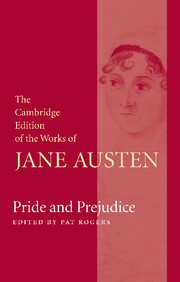Book contents
- Frontmatter
- Contents
- General Editor’s Preface
- Acknowledgements
- Chronology
- Introduction
- Note on the Text
- Pride and Prejudice
- Pride and Prejudice: Volume I
- Pride and Prejudice: Volume II
- Pride and Prejudice: Volume III
- Corrections and Emendations to 1813 text
- Appendix 1 Thomas Egerton and the Publication History
- Appendix 2 Legal and Military Background
- Appendix 3 Pemberley and its Models
- Appendix 4 Note on the second and third editions of Pride and Prejudice
- Abbreviations
- Explanatory Notes
Introduction
Published online by Cambridge University Press: 19 December 2020
- Frontmatter
- Contents
- General Editor’s Preface
- Acknowledgements
- Chronology
- Introduction
- Note on the Text
- Pride and Prejudice
- Pride and Prejudice: Volume I
- Pride and Prejudice: Volume II
- Pride and Prejudice: Volume III
- Corrections and Emendations to 1813 text
- Appendix 1 Thomas Egerton and the Publication History
- Appendix 2 Legal and Military Background
- Appendix 3 Pemberley and its Models
- Appendix 4 Note on the second and third editions of Pride and Prejudice
- Abbreviations
- Explanatory Notes
Summary
Nobody apart from the author herself can ever have found Pride and Prejudice ‘rather too light, & bright, & sparkling’, as she wrote in a letter to her sister, but it is certainly all three of these things. Its lightness comes from its high-spirited invention and its masterfully contrived comic plot. Its brightness appears above all in its control of tone, which permeates the narrative, description and dialogue. And as for sparkling qualities, they reside in the sustained wit of the novel, democratically shared between a range of characters, not forgetting the narrator herself. Too modestly, Jane Austen went on to tell Cassandra that
it wants shade;—it wants to be stretched out here & there with a long Chapter—of sense if it could be had, if not of solemn specious nonsense—about something unconnected with the story; an Essay on Writing, a critique on Walter Scott, or the history of Buonaparte—or anything that would form a contrast & bring the reader with increased delight to the playfulness & Epigrammatism of the general stile.
In reality, as generations of readers have testified, the book has a wonderful economy of means which incorporates a subtle gradation in moods and veins of feeling. Up to this period, the word ‘contrast’ had served mainly as a technical term in the fine arts: ‘The juxtaposition of varied forms, colours, etc., so as to heighten by comparison the effect of corresponding parts and of the whole composition’, as the Oxford English Dictionary puts it. Jane Austen employs the term as a connoisseur rather than as a literary critic; but nobody knows more about the effect of corresponding parts than she does.
The writer's playful remarks about her own playfulness disguise her realisation that she had outdone her predecessors in finding ways to diversify the texture of fiction without inserting segments unrelated to the action. Eighteenth-century English novelists had used the story within the story, as with the short interpolated narratives employed by Fielding in Tom Jones (1749) and by Smollett in Peregrine Pickle (1751), but they had been forced to sacrifice tonal consistency and narrative impetus.
- Type
- Chapter
- Information
- Pride and Prejudice , pp. xxii - lxxviiiPublisher: Cambridge University PressPrint publication year: 2006

